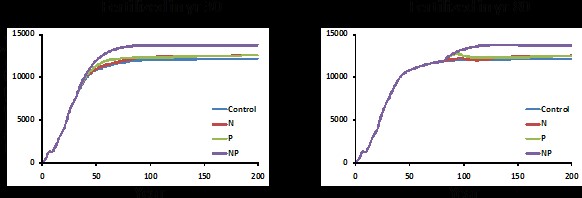SUNY ESF
Parametizing the MEL Model
Year 1
By Ed Rastetter, Marine Biological Laboratory
I spent most of this year finding parameters to run the MEL model for New England hardwood forests. This involved poring through the Hubbard Brook data sets and many email and Skype-conference calls with the project collaborators. We are honing in on a parameterization with which we are satisfied (Fig. 1).

Figure 1: Responses of plant biomass during re-growth from a bole-only harvest to N, P, and N plus P fertilization starting in year 30 and 80. Fertilizer was added at a rate of 12 g NH4 - N/m2/yr and 4 g PO4 - P/m2/yr.
We simulated N, P, and N plus P fertilization in a young (year 30) and a mature (year 80) forest. The forests were assumed to be recovering from a bole-only harvest (i.e., slash left in place) and fertilizer was added at a rate of 3 g NH4 - N/m2/yr and 1 g PO4 - P/m2/yr applied evenly from 15 May through 31 August. Fertilization began in either year 30 or 80 after the harvest and continued for the duration of the simulation.
The model indicates a stronger initial growth response in plants to P fertilization than N fertilization, but long-term responses that are comparable in magnitude (Fig. 1). There is a synergistic interaction in the N plus P fertilization such that the long-term growth response is larger than the sum of the growth responses to N or P fertilization alone.
The model indicates that soil organic matter accumulates for a short period after harvesting as the woody slash (simulated independently of soil organic matter) is assimilated into the soil (Fig. 2). Soil organic matter then declines because litter inputs are initially low relative to the rate of decomposition. Organic matter levels off and then accumulates slowly about 50 years after the harvest.
In the model, fertilization with N stimulates microbial activity enough to more than compensate for the increase in litter inputs elicited by the fertilization; thus the accumulation of soil organic matter with N fertilization is initially slightly slower than in the control, but then increases about 50 years after the fertilization begins and accumulates at a rate slightly faster that the control thereafter. Although P fertilization also stimulates microbial activity in the model, the stimulation was not enough to compensate for increased litter inputs and soil organic matter accumulated more rapidly in the P fertilized simulations than in the control. The synergism in the plant growth with N and P fertilization is propagated into high litter inputs to the soil. The stimulation of microbial activity was not enough to compensate for these high litter inputs and the N plus P fertilization had the fastest rates of soil organic matter accumulation among the four simulations.
We are currently trying to understand these responses, especially as relates to the relative N versus P limitation in plants versus soil microbes. We plan several sensitivity analyses related to this issue and a manuscript presenting the modeling results.
Broader impacts: To parameterize the MEL model, I have worked closely with R. Quinn Thomas, a graduate student of Christine Goodale's at Cornell University. Based on the graduate student training that has occurred through this project, Quinn is developing a collaboration with Gordon Bonan at National Center of Atmospheric Research to incorporate the resource optimization routine in MEL into the Community Land Model (CLM). The CLM is the land surface model in one of the global climate models (Community Earth System Model) that contributes to the Intergovernmental Panel on Climate Change report. Past work by others with the CLM has shown multiple element interactions (carbon and nitrogen) to have an important influence on how elevated CO2 affects global climate in the absence of resource optimization. However, the influence of multiple resource optimization on climate change (including water and light in addition to carbon and nitrogen) is unknown, but the model development, parameterization, and application of the MEL model in this project will directly inform the model development needed to address this question.
